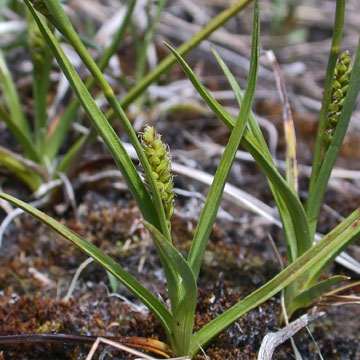

Carex crawei - (image 1 of 5)
Taxonomy
Family: Cyperaceae
Section Granulares
Habitat
Calcareous wet meadows, shores, fens, rock ledges, limestone pavements.
Associates
Distribution
Quebec to British Columbia, south to NJ, TN, AL, and AR.
Morphology
Perennial, solitary or loosely clustered on long rhizomes; stems stiff, 10-30 cm; leaves thick, stiff, pale green, 1-4 mm wide, usually curved or recurved; terminal spike staminate, 1-2 cm, on an elongate peduncle, overtopping the pistillate spike and usually the bracts; pistillate spikes 2-4, the lowest nearly basal, on short-exsert peduncles, the upper shorter-pedunculate or subsessile, short-cylindric, 1-1.5 cm; pistillate scales triangular ovate, much shorter than the perigynia, acute, acuminate or short-cuspidate; perigynia crowded in several rows, ovoid to ellipsoid, 2.1-3.5 mm, sharply or obscurely nerved, rather abruptly tapering into a very short, straight beak.
Notes
Fruiting late May to July
Wetland indicator: FACW
Rare in NY, found primarily in the northern part of the state on alvars. Similar to C. granularis which grows in the same habitats and has a terminal spike that is sessile or nearly so, wider leaves, and much shorter rhizomes.
References
Gleason, Henry A. and A. Cronquist. 1991. Manual of Vascular Plants of
Northeastern United States and Adjacent Canada. Second Ed.
The New York Botanical Garden. Bronx, NY
|
© Michael Hough 2018 |